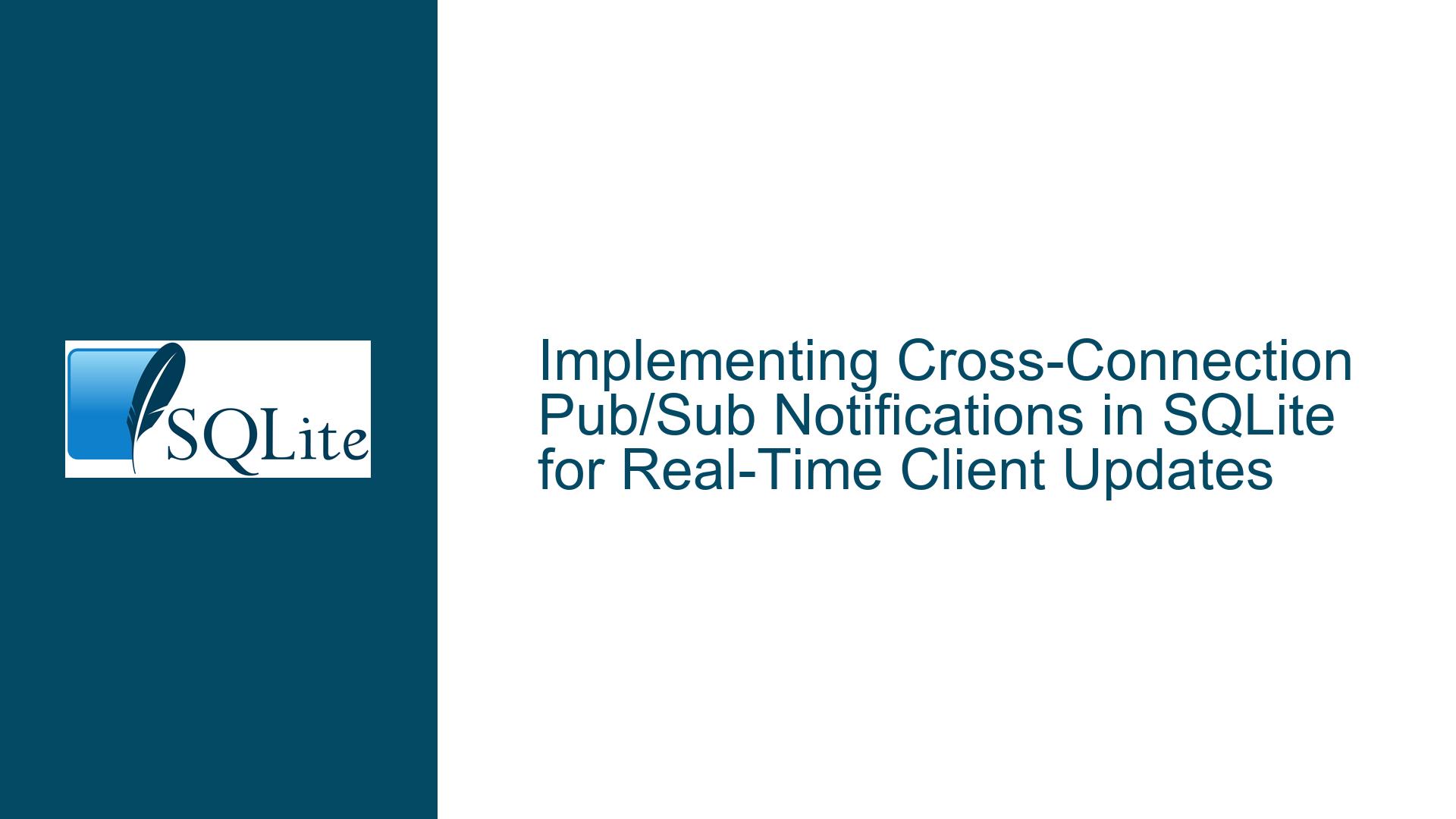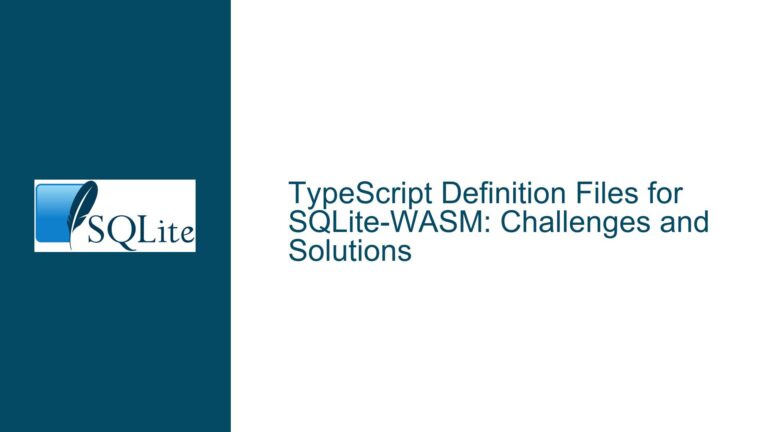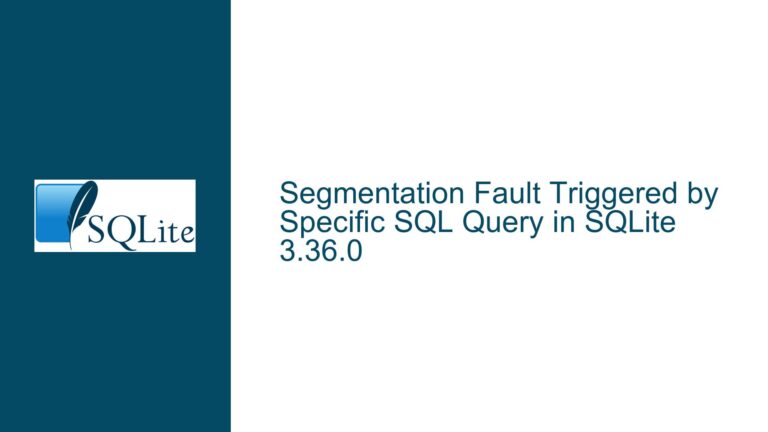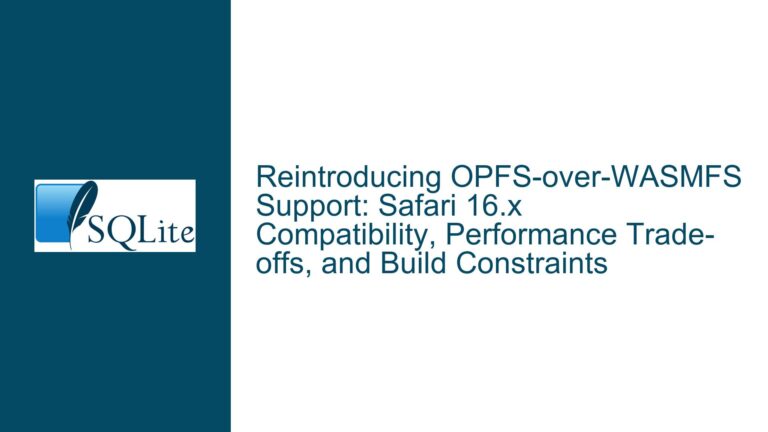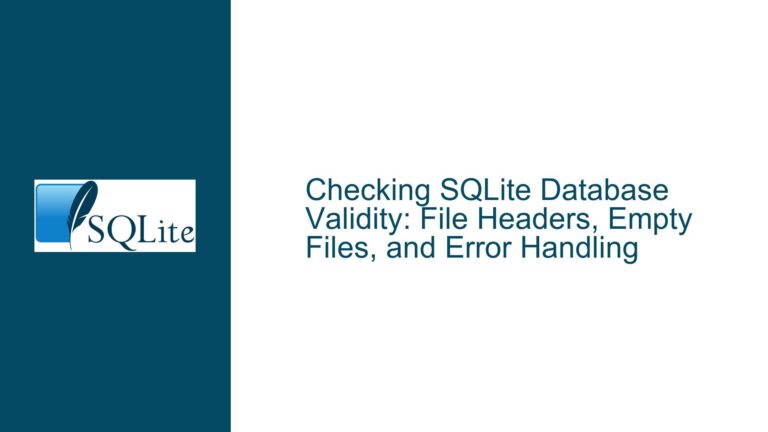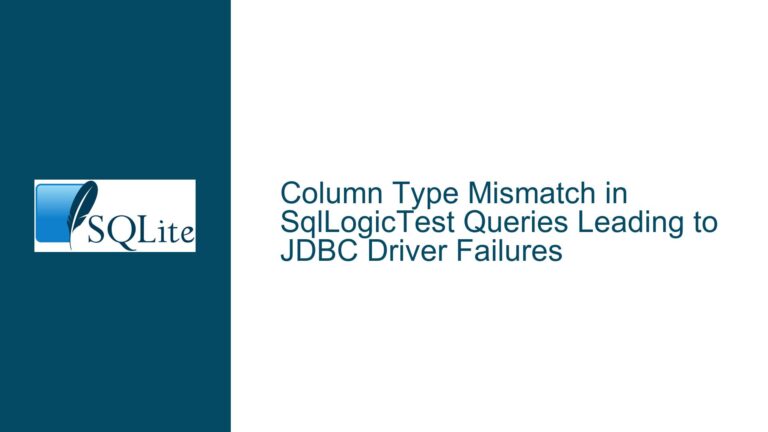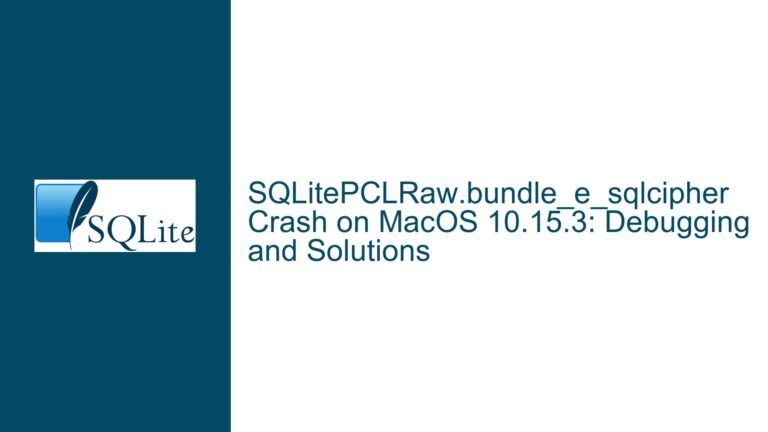Implementing Cross-Connection Pub/Sub Notifications in SQLite for Real-Time Client Updates
Asynchronous Event Propagation Across SQLite Connections: Core Challenges and Architectural Solutions
Issue Overview: Absence of Native Publish-Subscribe Mechanism in Multi-Connection Environments
SQLite operates as an embedded database engine without a centralized server process, making cross-connection communication inherently challenging. When multiple clients interact with the same database file, there is no built-in mechanism for one connection to notify others about data changes. This limitation becomes critical in scenarios requiring real-time synchronization between clients – such as collaborative text editors, live dashboards, or event-sourcing architectures where UI components must reflect database mutations instantly.
The core problem manifests in three dimensions:
- Connection Isolation: Triggers and
sqlite3_update_hookonly fire for changes made through the same database connection. A client inserting records via Connection A cannot directly alert Connection B about the change through SQLite’s native APIs. - Notification Targeting: Even if global triggers could propagate events, SQLite lacks intrinsic methods to address notifications to specific clients. Broadcast-style notifications would force all clients to process irrelevant events, wasting computational resources.
- Polling Overhead: Frequent polling (e.g.,
SELECT MAX(rowid) FROM eventsevery 50ms) introduces CPU load and I/O contention. While SQLite handles simple queries efficiently, this approach becomes unsustainable at scale or in battery-constrained environments.
The architectural mismatch stems from SQLite’s design philosophy: it prioritizes simplicity and portability over server-style features like inter-process communication. Solutions must therefore layer notification systems on top of SQLite’s existing primitives rather than expecting built-in pub/sub capabilities.
Possible Causes: Why Native SQLite Operations Fail to Enable Cross-Client Signaling
1. Ephemeral Connection Lifetime
SQLite connections exist as independent entities with no awareness of each other. When Client B opens a connection to database.db, it cannot query metadata about Client A’s connection state – including whether Client A even exists. This isolation prevents direct IPC (inter-process communication) channels between connections through standard SQLite APIs.
2. Write-Ahead Log (WAL) File Observability Limitations
While the WAL file (<database>-wal) reflects uncommitted changes, monitoring it via filesystem watchers (e.g., inotify on Linux) proves unreliable:
- WAL writes occur asynchronously, so filesystem events may lag behind actual data changes.
- Multiple clients writing concurrently generate non-deterministic WAL update patterns.
- Portable filesystem notification APIs don’t exist across all target platforms (Windows, macOS, mobile OSes).
3. Trigger Scope Constraints
Triggers created via CREATE TRIGGER do fire for writes from any connection, but they execute within the context of the modifying connection. A trigger cannot directly invoke code in another process or connection. For example, the following trigger would only increment a counter in Connection A’s memory if Connection A inserted the row:
CREATE TRIGGER notify_change AFTER INSERT ON commands
BEGIN
SELECT increment_counter(); -- User-defined function in Connection A
END;
4. Opaque Database Connection Handles
The sqlite3 API treats connection objects as opaque pointers. While one might theoretically pass file descriptors between processes to enable signaling, this violates process isolation boundaries and introduces security risks. Platform-specific IPC mechanisms (Unix domain sockets, named pipes) require explicit implementation outside SQLite.
Troubleshooting Steps, Solutions & Fixes: Building a Hybrid SQLite-IPC Notification Layer
Solution 1: Changelog Table with Optimized Polling
Implementation Strategy
- Create a
changelogtable with monotonic sequencing:
CREATE TABLE changelog (
seq INTEGER PRIMARY KEY AUTOINCREMENT,
table_name TEXT NOT NULL, -- Affected table (e.g., 'commands')
operation TEXT NOT NULL, -- 'INSERT', 'UPDATE', 'DELETE'
rowid INTEGER NOT NULL, -- Affected row ID
timestamp DATETIME DEFAULT CURRENT_TIMESTAMP
);
- Insert into
changelogvia triggers on target tables:
CREATE TRIGGER log_command_insert AFTER INSERT ON commands
BEGIN
INSERT INTO changelog (table_name, operation, rowid)
VALUES ('commands', 'INSERT', NEW.rowid);
END;
- Clients poll using a windowed query:
-- Client stores last_seen_seq = 100
SELECT seq, table_name, operation, rowid
FROM changelog
WHERE seq > 100
ORDER BY seq ASC;
Optimization Techniques
- Indexing: Ensure
changelog.seqis indexed (automatically handled byINTEGER PRIMARY KEY). - Batch Pruning: Periodically delete old records with
DELETE FROM changelog WHERE seq < (SELECT MAX(seq) - 1000 FROM changelog); - Polling Interval Tuning: Use adaptive polling based on system load. Start with 200ms intervals, increasing to 2s during inactivity.
Performance Characteristics
- Read Cost: A
WHERE seq > ?query over an indexed column typically executes in microseconds, even with millions of rows. - Write Amplification: Each data modification incurs an additional write to
changelog. UsePRAGMA synchronous=NORMALto mitigate fsync overhead.
Solution 2: Schema Version Ping-Pong via PRAGMA user_version
Architecture
- Reserve
PRAGMA user_versionas a change counter:
-- Increment on any data change
CREATE TRIGGER increment_version AFTER INSERT ON commands
BEGIN
PRAGMA user_version = user_version + 1;
END;
- Clients poll the version:
PRAGMA user_version;
- When the version changes, clients fetch new data:
SELECT * FROM commands WHERE rowid > ?;
Advantages
- Atomic Updates:
user_versionincrements atomically with data writes, eliminating race conditions. - Zero Schema Overhead: No additional tables or indexes required.
Limitations
- No Change Context: Clients must re-query entire tables or track row IDs separately.
- Version Wrap-Around: Using a 32-bit integer limits the version space to 4,294,967,295 increments.
Solution 3: Custom IPC Functions via SQLite Extensions
Step-by-Step Implementation
- Define a Virtual Table for Subscribers
CREATE TABLE subscribers (
channel TEXT NOT NULL, -- e.g., 'commands'
pid INTEGER NOT NULL, -- Process ID (OS-specific)
fd INTEGER NOT NULL, -- File descriptor for Unix socket
last_notified_seq INTEGER -- Track last sent changelog seq
);
- Create User-Defined Functions (UDFs)
- LISTEN(channel): Inserts the client’s PID and socket FD into
subscribers, opens an IPC channel. - UNLISTEN(channel): Removes the client from
subscribers, closes IPC channel. - NOTIFY(channel, message): Called by triggers, broadcasts messages to subscribers via IPC.
IPC Backend Options
- Unix Domain Sockets (Linux/macOS):
// LISTEN() UDF implementation
static void listen_udf(sqlite3_context *context, int argc, sqlite3_value **argv) {
int fd = socket(AF_UNIX, SOCK_DGRAM, 0);
struct sockaddr_un addr = {.sun_family = AF_UNIX};
snprintf(addr.sun_path, sizeof(addr.sun_path), "/tmp/sqlite-notify-%d", getpid());
bind(fd, (struct sockaddr*)&addr, sizeof(addr));
// Insert fd into 'subscribers' table
}
- Named Pipes (Windows):
HANDLE pipe = CreateNamedPipe(
L"\\\\.\\pipe\\sqlite-notify",
PIPE_ACCESS_DUPLEX,
PIPE_TYPE_MESSAGE | PIPE_READMODE_MESSAGE,
PIPE_UNLIMITED_INSTANCES,
1024, 1024, 0, NULL
);
Trigger Integration
CREATE TRIGGER notify_command_insert AFTER INSERT ON commands
BEGIN
SELECT NOTIFY('commands', NEW.rowid);
END;
Client-Side Handling
- Registration:
# Python example
conn.execute("SELECT LISTEN('commands')")
fd = conn.execute("SELECT fd FROM subscribers WHERE pid = ?", (os.getpid(),)).fetchone()[0]
sock = socket.socket(fileno=fd)
- Event Loop:
while True:
message = sock.recv(1024)
print(f"New command: {message.decode()}")
Security Considerations
- FD Leakage: Ensure file descriptors are closed when connections terminate. Use
sqlite3_close_hookto clean up. - Permission Isolation: Restrict socket/pipes to user-owned directories (e.g.,
/run/user/$UID).
Solution 4: Hybrid Approach with Changelog and IPC Notifications
Architecture
- Changelog Table: Track all mutations as in Solution 1.
- IPC Notification: On
changeloginsert, send a lightweight ping via IPC. - Lazy Data Fetching: Clients react to pings by querying
changelogfor new entries.
Trigger Definition
CREATE TRIGGER ping_on_change AFTER INSERT ON changelog
BEGIN
SELECT NOTIFY('changelog', NEW.seq);
END;
Client Workflow
- Receive ping with latest
seqvia IPC. - Query
changelogforseq > last_known_seq. - Batch process changes.
Advantages
- Reduced IPC Payload: Only sequence numbers are sent, minimizing bandwidth.
- Transactional Consistency: Clients fetch data after it’s committed, avoiding race conditions.
Solution 5: Filesystem Monitoring with WAL Observation
Implementation Notes
- WAL File Polling:
# Check WAL size periodically
stat -c %s /path/to/db-wal
- Change Detection Heuristics:
- WAL file grows when transactions are committed.
- WAL is reset to zero when a checkpoint occurs (
PRAGMA wal_checkpoint).
Limitations
- False Positives: WAL growth doesn’t indicate which tables changed.
- Platform Variance: Windows requires
ReadDirectoryChangesW, while macOS useskqueue.
Solution 6: Shared Memory Region for Change Flags
Advanced Technique (POSIX Systems)
- Create Shared Memory Object:
int fd = shm_open("/sqlite-changes", O_CREAT | O_RDWR, 0666);
ftruncate(fd, sizeof(int));
int *flag = mmap(NULL, sizeof(int), PROT_READ | PROT_WRITE, MAP_SHARED, fd, 0);
- Update Flag in Triggers:
-- Requires UDF to increment shared memory
CREATE TRIGGER set_change_flag AFTER INSERT ON commands
BEGIN
SELECT increment_shared_counter();
END;
- Client Monitoring:
while (*flag == last_value) {
usleep(100000); // 100ms
}
last_value = *flag;
Synchronization Requirements
- Use atomic operations (
__atomic_add_fetchin GCC) to prevent race conditions. - Consider semaphores for multi-process coordination.
Critical Evaluation of Approaches
| Approach | Latency | CPU Overhead | Implementation Complexity | Cross-Platform Viability |
|---|---|---|---|---|
| Changelog Polling | High (~100ms) | Moderate | Low | Excellent |
| user_version Ping | Medium | Low | Low | Excellent |
| Custom IPC | Low (~1ms) | Low | High | Moderate (OS-specific) |
| WAL Monitoring | Variable | Low | Moderate | Poor (POSIX-centric) |
Recommendations by Use Case
- Desktop Apps with Sparse Updates:
user_versionpolling provides simplicity and efficiency. - High-Throughput Services: Custom IPC with batched changelog queries balances latency and throughput.
- Mobile/Embedded Systems: Hybrid changelog-IPC minimizes wakeups for battery efficiency.
Debugging Common Pitfalls
Symptom: Notifications are missed under high load.
- Cause: IPC buffer overflow due to rapid event sequence.
- Fix: Implement client-side batching – accumulate multiple events before waking the main thread.
Symptom: False positive WAL change notifications.
- Cause: Checkpoints or vacuum operations resetting the WAL.
- Fix: Track
PRAGMA wal_checkpointcalls and ignore size changes during maintenance.
Symptom: subscribers table accumulates stale entries.
- Cause: Clients crash without unregistering.
- Fix: Implement heartbeat mechanism – clients update a
last_seentimestamp periodically. Prune entries older than a threshold.
Conclusion
Achieving cross-connection notifications in SQLite demands creative use of its extensibility features – whether through carefully optimized polling, custom functions leveraging OS IPC, or hybrid approaches that balance immediacy with resource constraints. While no solution replicates PostgreSQL’s LISTEN/NOTIFY exactly, the combination of triggers, user-defined functions, and platform-specific inter-process communication can yield a robust event propagation system tailored to your application’s latency and scalability requirements. Developers must weigh the trade-offs between implementation complexity and performance, often finding that SQLite’s lightweight polling options suffice for many real-world scenarios once properly optimized.
